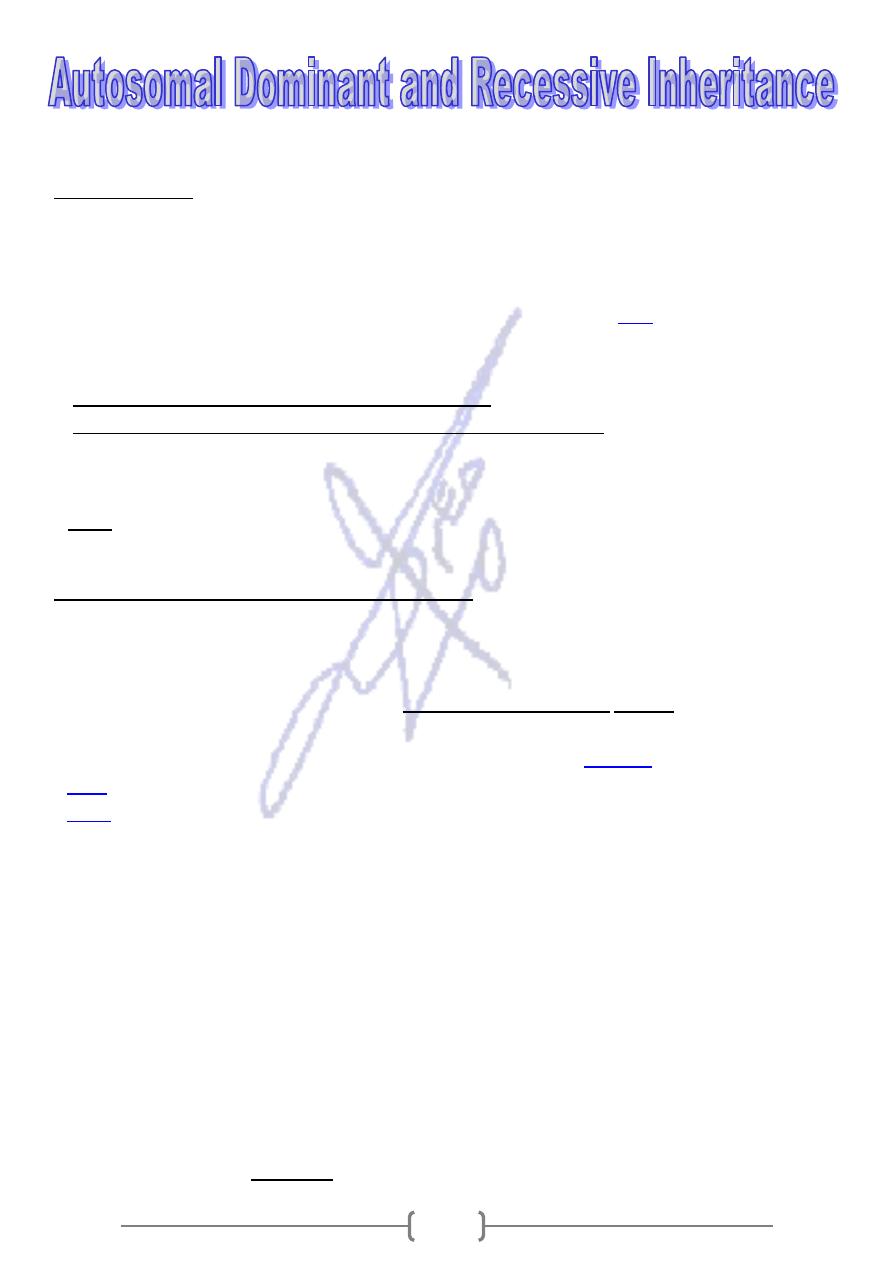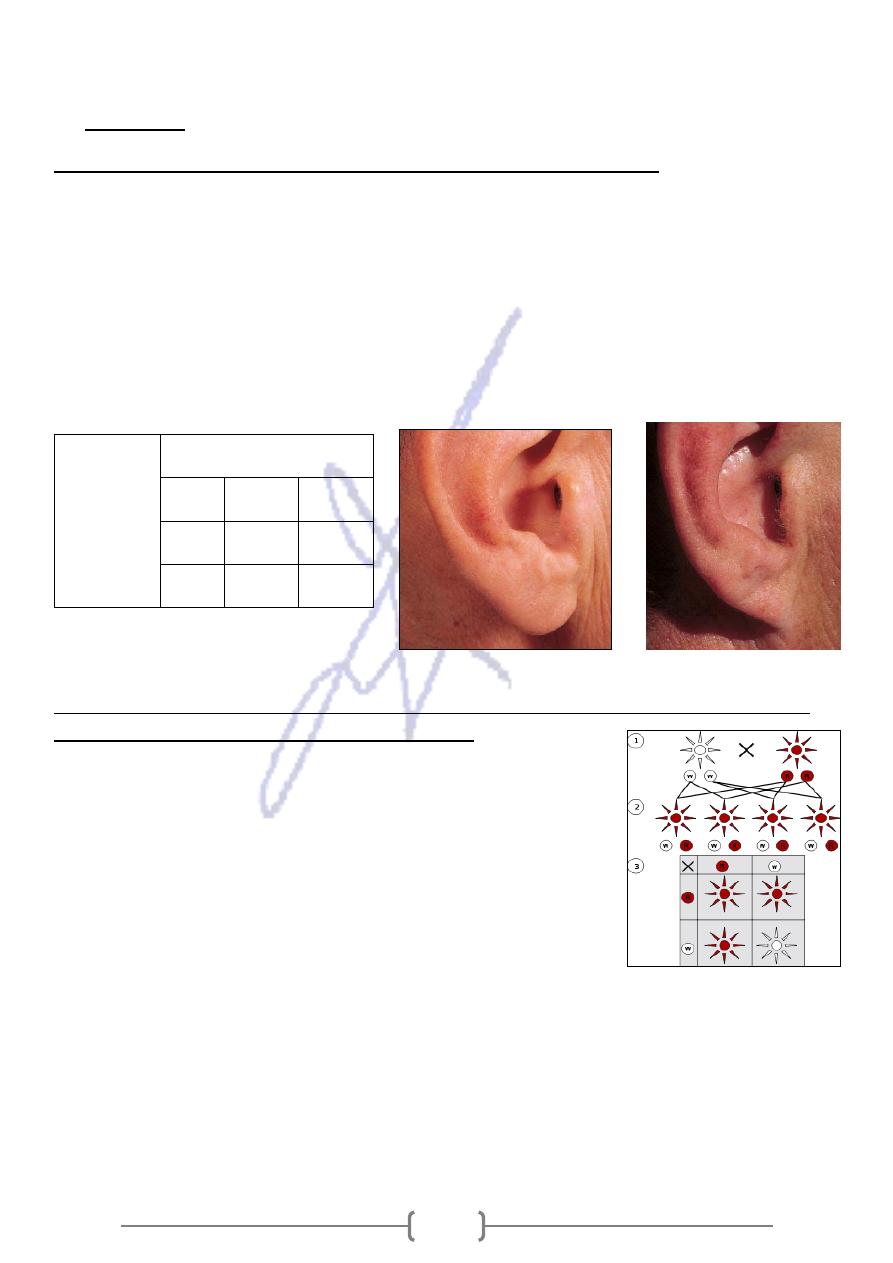
111
Mendel's Laws
* The simple genetic characters are those which presences or absence depends on the
genotype at a single locus.
* Expression of any human character is required a large number of genes and environmental
, one from each
trait
ual has two alleles for each
Mendel stated that each individ
factors.
parent.
* The two alleles may or may not contain the same genetic information.
for the trait.
homozygous
If the two alleles are identical, the individual is called
-
.
heterozygous
o alleles have different information, the individual is called
If the tw
-
* In heterozygous individuals the only allele that is expressed is the dominant. The recessive
allele is present but its expression is hidden.
that dominance and recessiveness are properties of characters not genes.
Note
*
* Most human dominant syndromes are known only in heterozygous.
The central principles of Mendel's work are two laws:
1. Law of Segregation (The "First Law")
It states that sexually reproducing organisms posses genes that occur in pairs (diploid)
of only one of
(allele)
a randomly selected copy
for any particular trait each parent passes
*
these to its offspring (segregates).
the copies of a
,
gametes
More precisely the law states that when any individual produces
-
one
separate so that each gamete receives only one copy (allele). A gamete will receive
ene
g
.
allele
- The principle of segregation state is that genes are not blended in the offspring, in contrast
genes remain intact and distinct. (e.g. the color of a person's eyes).
- An allele can be transmitted to an offspring in the next generation. So it would be impossible
to trace genetic inheritance from one generation to the next.
2. Law of Independent Assortment (The "Second Law")
* Genes at different loci are transmitted independently of one another during gamete
formation from parents to offspring.
* The principle of independent assortment is that the allele transmitted at one locus to the
offspring has no effect on the selection of other allele at the other locus.
* Mendel concluded that different traits are inherited independently of each other, so that
there is no relation, for example, between a cat's color and tail length. This is actually true
to each other.
not linked
only for genes that are

112
* In independent assortment the chromosomes that result are randomly sorted from all
possible combinations of maternal and paternal chromosomes, and the gametes end up with
defined "set" from either parent
-
instead of a pre
random mix
a
homozygote parents
hh
and
HH
Punnet square illustrating a cross between
* Mendel’s experiment also showed that the effects of one allele may mask those of another. He
performed crosses (mating) between plants homozygous for the red tall gene (two identical
copies of an allele label H), and plants homozygous for the short gene (having two copies of an
allele h). This cross can only reproduce heterozygous (Hh) offspring. This reflect the fact that H
allele is dominant, while h alelle is recessive.
* For example, unattached (free) earlobes (picture on the left) are dominant over attached
earlobes (picture on the right), so a suitable key would be EE or Ee for unattached earlobes and
ee for attached earlobe
between dominant
Mendel's experiments with mixing one trait always resulted in a 3:1 ratio
and recessive phenotypes in the second generation.
This figure show the Dominant and recessive phenotypes.
(1) Parental generation.
(2) F
1
generation.
(3) F
2
generation.
* Dominant (red) and recessive (white) phenotype look alike in the
F
1
(first) generation and show a 3:1 ratio in the F
2
(second)
generation. (ww) homozygous recessive
* Any of the possible combinations of gametes formed from maternal and paternal
chromosomes will occur with equal frequency. For human gametes, with 23 pairs of
chromosomes, the number of possibilities is 2
23
or 8,388,608 possible combinations.
* The gametes will normally end up with 23 chromosomes, but the origin of any particular one
will be randomly selected from paternal or maternal chromosomes. This contributes to the
genetic variability of progeny.
Parent
Parent
h
h
Hh
Hh
H
Hh
Hh
H

113
Dominance and recessiveness are properties of character, not genes:
A character is dominant if it is manifest in the heterozygote and recessive if not. Thus sickle cell
anemia is recessive because only HbS homozygous manifest it. Heterozygous for the same gene
show sickling trait, which is therefore a dominant character. Most human dominant syndromes are
known only in heterozygotes. Sometimes homozygotes are born from mating two heterozygous
affected people, and much more severely affected.
There are five basic mendelian pedigree patterns:
* Mendilian characters may be determined by loci on an autosome or on the X or Y sex
chromosomes.
* Autosomal character in both sexes and X- linked character in females can be dominant or
recessive.
* Nobody has two genetically different Y chromosome (in the rare XYY males, the two Y
chromosomes are duplicated).
Thus there are five mendelian pedigree patterns.
1. Autosomal Dominant inheritance:
* An affected offspring usually has at least one affected parent.
* Affects either sex
* Transmitted by either sex
has 50% chance of being affected (this assumes the
A child of an affected X unaffected mating
*
affected parent is heterozygous). So half of the children will be heterozygotes and will express
the disease, while half will be normal homozygotes.
the presence of an extra digit next to the fifth digit.
Postaxial polydactyly,
Example:
* There is no skipping of generations: if an individual has polydactyly, one parent must also
have it.
* This leads to a vertical transmission pattern, in which the disease phenotype is usually seen
in one generation after another.
* If neither parent has the trait, none of the children will have it.
Each birth is an
Recurrence Risk:
Roughly equal numbers of affected males and females.
*
independent event, thus even the parent have already had a child with disease, their
recurrence risk remain and the probability that their next child will have the disease is still ½
(50%).
The Punnett square illustrates that the affected parent
can pass either a disease gene or a normal gene to his or
her children, each event has the probability of 0.5%.
Unaffected parent
Affected
parent
a
a
Aa
Aa
A
aa
aa
a

114
2. Autosomal recessive inheritance:
* Affected people are usually born to unaffected parents (heterozygous).
* Parents of affected people are usually asymptomatic carriers.
* There is an increased incidence of parental consanguinity (Latin, with blood) refers to the
mating of related individuals.
* Affect either sex
that results from mutation in the gene that encodes tryrosinase, a
Albinism
Example:
*
tyrosine- metabolizing enzyme. The resulting tyrosinase deficiency creates a block in the
metabolic pathway that normally leads to the synthesis of melanin pigment. The affected
individual has very little pigment in the skin, hair and eyes.
* Because melanin is also required for the normal development of the optic fibers, albinos may
also display nystagmus (rapid uncontrolled eye movement) and reduced visual acuity.
horizontaly transmitted
Unlike autosomal dominant disease, autosomal recessive disease are
*
usually observed multiple siblings but not in earlier generation.
affected child, each subsequent child has a 25% chance
After the birth of an
:
Recurrence Risk
*
of being affected
The Punnett square demonstrate one fourth (1/4)of the
offspring of two heterozygotes will be normal
homozygotes, half (1/2)will be phenotypically normal
heterozygous carriers, and one fourth (1/4)will be
homozygotes affected with the disease
linked recessive inheritance:
-
3. X
* Affect mainly males
* Affected males are usually born to unaffected parents, the mother is normally an
asymptomatic carrier and may have affected male relatives
* Females may be affected if the father is affected and the mother is a carrier, or occasionally
as a result of non- random X- inactivation
* There is no male- to- male transmission in the pedigree (but mating of an affected male and
carrier female can give the appearance of male transmission)
linked dominant inheritance:
-
4. X
* Affects either sex, but more females than males
* Females are often more mildly and more variably affected than males
* The child of an affected female, regardless of its sex, has 50% chance of being affected
* For an affected male, all his daughters but none of his sons are affected
linked inheritance:
-
5. Y
* Affect only males
* Affected males always have an affected father (unless there is a new mutation)
* All sons of affected man are affected
Carrier Parent
Carrier
Parent
a
A
Aa
AA
A
aa
Aa
a
